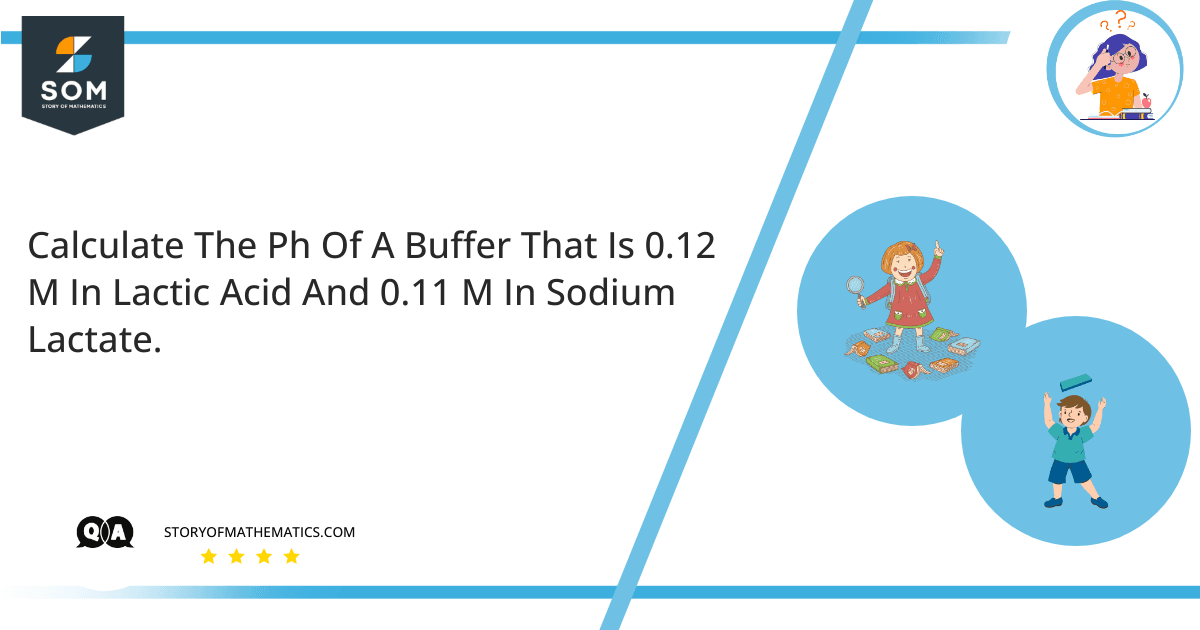
The question aims to find the pH of a buffer.
The measure of acidity or authenticity of aqueous or other liquid solutions is defined as pH. This term is normally used in chemistry, biology, and agronomy, and translates concentrations of hydrogen ions — usually between 1 and 10−14 per gram per liter — into numbers between 0 and 14.
A simple buffer solution contains an acid solution and salt conjugate base acid. For example, acid can be acetic, and salt can be sodium acetate. The Henderson Hasselbalch calculator associates the $pH$ of a solution consisting of a mixture of two particles with the stability of acid separation, the $Ka$ of acid, and the concentration of the solution type.
Following simplifying assumptions are used to derive the equation.
Assumption 1: Acid, $HA$, monobasic and differentiates according to the equation.
\[HA\rightleftharpoons H^{+}+A^{-}\]
\[C_{a}=[A^{-}]+\dfrac{[H^{+}][A^{-}]}{K_{a}}\]
\[C_{H}=[H^{+}]+\dfrac{[H^{+}][A^{-}]}{K_{a}}\]
$C_{a}$ is the concentration of acid analysis and $CH$ is the concentration of hydrogen ion that has been added to the solution.
The Henderson Hasselbalch scale can only be used in polybasic acid if its consecutive $pH$ values vary by at least $3$. Phosphoric acid is such an acid.
Assumption 2: Water self-ionization can be overlooked. This argument is not, at present, permissible with $pH$ values close to $7$, half the $pK_{w}$ value, which is a constant ionization of water. In this case, the mass-balance equation of hydrogen should be extended to consider water ionization.
\[C_{H}=\dfrac{[H^{+}][A^{-}]}{K_{a}}+\dfrac{K_{w}}{H^{+}}\]
Assumption 3: Salt $MA$ is completely separated from the solution. For example, sodium acetate
\[Na(CH_{3}CO_{2}\rightarrow Na^{+}+CH_{3}CO_{2}^{-} \]
saturation of sodium ion, $[Na ^{+}]$ is ignored. This is a good ratio for $1: 1$ electrolyte, but not ion salts with a high charge like magnesium sulphate, $Mg (SO_{4})_{2}, which makes ion pairs.
Assumption 4:
Value of the $K_{a}$
\[K_{a}=\dfrac{[H^{+}][A^{-}]}{HA}\]
Rearrangement of this equation and logarithm provision gives the Henderson Hasselbalch equation:
\[pH=pK_{a}+\log\dfrac{A^{-}}{HA}\]
The Henderson-Hasselbalch equation is used to find the $pH$ of the solution.
Expert Answer
Using Henderson-Hasselbalch equation:
\[pH=pK_{a}+\log\dfrac{A^{-}}{HA}\]
$HA(CH_{2}CHOHCOOH)$ is the acid $A^{-}(CH_{2}CHOHCOONA)$ is its conjugate base.
$pK_{a}$ is given, which is acid strength.
\[pK_{a}=3.86\]
The acid value is given as:
\[CHOHCOOH=0.12 M\]
The conjugate base is given as:
\[CHOHCOONA=0.11 M\]
Plug the values into the Henderson-Hasselbalch equation to calculate the $pH$.
\[pH=3.86+\log\dfrac{0.11}{0.12}\]
\[pH=3.822\]
Hence, $pH$ is $3.822$.
Numerical Result
Buffer that has $pH$ $0.12$ $M$ in lactic acid and $0.11$ $M$ in sodium lactate is calculated as:
\[pH=3.822\]
Example
Find the $pH$ of a buffer that is $0.15$ $M$ in lactic acid and $0.17$ $M$ in sodium lactate.
Henderson-Hasselbalch equation is used to find the $pH$ of the solution.
\[pH=pK_{a}+\log\dfrac{A^{-}}{HA}\]
$HA(CH_{2}CHOHCOOH)$ is the acid $A^{-}(CH_{2}CHOHCOONA)$ is its conjugate base.
$pK_{a}$ is shown below, which is acid strength.
\[pK_{a}=3.86\]
The acid value is given as:
\[CHOHCOOH=0.15 M\]
The conjugate base is given as:
\[CHOHCOONA=0.17 M\]
Plug the values into the Henderson-Hasselbalch equation to find the $pH$.
\[pH=3.86+\log\dfrac{0.17}{0.15}\]
\[pH=3.914\]
Buffer with $0.15$ $M$ in lactic acid and $0.17$ $M$ in sodium lactate has $pH$ calculated as:
\[pH=3.914\]
Hence, $pH$ is $3.914$.
